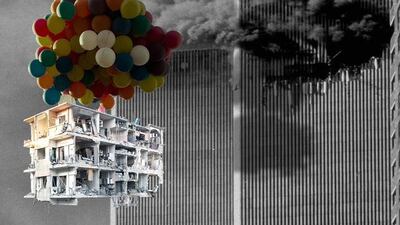Transported by a bunch of brightly coloured balloons, a war-torn tenement building lifted from the streets of Damascus floats past New York’s Twin Towers as black smoke billows from them during the September 11 attacks.
The image, entitled New York, was exhibited in a group show in London, which was part of a campaign called Art4Peace that ran for two weeks this month. Organisers asked the 20 participating artists to reflect on opportunities for peaceful change in an increasingly conflicted world.
The altered image of the World Trade Center is one of the most recognisable – Tammam Azzam’s superimposed additions to it highlight the lack of attention given to the Syrian people by western powers.
“This work illustrates the many different emotions and consequences experienced by different peoples around the world as a result of 9/11,” Azzam says. “Clearly, the event was one of the most dramatic and tragic events of our lifetime – but the lack of empathy and assertive action for the myriad other acts of terrorism and humanitarian disasters around the world troubles me. Empathy should not be limited to the First World.”
Azzam, who has lived in Dubai and worked from the city's Ayyam Gallery since he was forced from his home in Damascus, has created several similarly altered images for his latest series, Bon Voyage.
That same building floats next to some of the world’s most iconic landmarks in works that offer a poignant reminder that there are no “good travels” for the people of Syria, and reference the exodus of refugees from the country as well as the civilians who remain within its borders.
The juxtaposition of the cheerfully innocent balloons alongside the hollow shell of the bombed-out building evokes the hundreds of lives and histories that were lost in its destruction.
“In these difficult times, the only thing that I can do as an artist is to try to make evocative and thoughtful images relating to what I have witnessed, to give the world a better understanding of the situation,” says Azzam. “If my work can raise some money or even just raise awareness, I feel I have done my job.”
The exhibition ran at the same time as Banksy’s Dismaland, the pop-up show devised by the United Kingdom’s most famous street artist, and took the form of a “bemusement park” in the small coastal town of Weston-super-Mare. Azzam was one of six Arab artists chosen to participate in the high-profile show, which also included big names such as Damien Hirst, Jenny Holzer and, of course, Banksy himself.
Freedom Graffiti – Azzam's famous image that went viral in 2013, in which he superimposed Gustav Klimt's The Kiss on a bombed-out building – was part of the Banksy show.
“I am a huge fan of Banksy and couldn’t be more honoured that my art was hand-picked to feature at his extraordinary Dismaland,” Azzam says. “What Banksy does best is to bring art to a much wider audience and I think his anti-establishment attitude should be an inspiration to all artists.”
Although the work is a few years old, it still holds incredible relevance given the continuing situation in Syria. With a solo exhibition at Ayyam Gallery also in the pipeline, and a renewed international profile, Azzam’s reputation continues to grow.
• Find out more about Tammam Azzam on Ayyam Gallery’s website www.ayyamgallery.com
aseaman@thenational.ae

